Abstract
Currently, the 40-year-long reference period 1961–2000 is used in Slovakia for systematic assessment of the hydrological regime. The World Meteorological Organization recommends unifying the climatic normal 1991–2020 with a reference period for hydrological characteristics for the purpose of climate change research. We have analyzed changes in the long-term mean annual discharges at 113 water-gauging stations over different time periods. Considering the history of the reference periods used in Slovakia, we have focused on the analysis of the 10, 20, 30, 40, and 50-year-long moving averages of the long-term mean annual discharges in the period 1961–2020 in comparison with the 1961–2000 reference period and the whole selected and analyzed period. The deviations of the annual flow rates for the area of Slovakia and river sub-basins have been analyzed. The results indicate that the new reference period to be used in Slovakia should include the time period after the year 2000. To determine its precise length, a more detailed analysis is needed.
1. Introduction
In the times of a global acceleration of the effects of climate change, a rising number of extreme weather phenomenon occurrences has been observed worldwide [1], including in Slovakia [2,3,4,5]. These include long periods of warm weather without any precipitation causing droughts, followed by local storms with high intensities causing dangerous flood events. The unevenness of the spatial and temporal distribution of water resources forces us to systematically study the circulation of water in nature and its changes. An understanding of this issue is crucial for the protection of water resources, their rational use, and the protection of society from the consequences of extreme hydrological situations.
The hydrological design values set for the reference period are similar to the limit values that are an integral part of many national decision-making processes (e.g., flood protection, measures dealing with the effects of hydrological drought, permits for water use, and design activities in the construction industry, etc.). Currently, the reference period 1961–2000 is still used in Slovakia for the systematic evaluation of the hydrological regime. During recent years, changes in the hydrological regime of Slovak rivers were observed and studied by many authors [6,7,8,9,10,11,12,13] As well as the World Meteorological Organisation (WMO) [14], which recommends the 30-year period 1991–2020 for the purpose of the comparison of the hydrological and climatic characteristics. Therefore, there is an increased need to re-evaluate the currently used reference period.
The aim of this contribution is to present partial results of a current national study [15]. The study considers the assessment of spatial and temporal changes in one of the basic hydrological characteristics, the long-term flow in the rivers of the Slovak basins.
2. Materials and Methods
The hydrological characteristics determined for the selected reference period represent the “normal” for a certain period. They are considered to be a selected “fixed point” to which the corresponding characteristics are compared for an evaluation of the past, present, and possible future development of the hydrological regime. In 2020, WMO, through the Hydrological Panel, issued an opinion on the concept of a “hydrological normal” in which it pointed out the absence of a definition of the “hydrological normal” or the “normal/reference hydrological period.” Only the more general concept of a “normal” is defined as “moving averages calculated over a uniform and relatively long period covering at least three consecutive decades” [14].
In Slovakia, the 40-year period (1961–2000) is currently used as the reference period for hydrological characteristics. It was preceded by a 50-year reference period 1931–1980 and the 30-year period 1931–1960. This means that before the current 40-year reference period, two reference periods of different lengths were used for the assessment of the hydrological regime. The studies show that the selection of the reference period and its length has an impact on the results of the analyses of the hydrological regime [16].
One of the basic characteristics of the hydrological regime is the long-term flow over the reference period. Considering the hydrological practice in the history of reference periods used in Slovakia, we have focused on the analysis of the development of 10-, 20-, 30-, 40- and 50-year moving averages of long-term flows in the period 1961–2020.
For the analysis, we have selected 113 water-gauging stations with hydrological regimes that have been unaffected by human activities such as dams or large withdrawals, with observations starting at least from the period 1961–1970 (Figure 1).
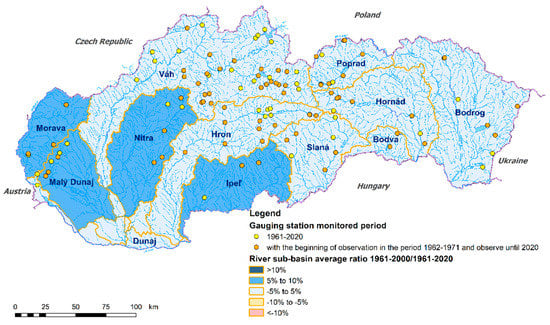
Figure 1.
Selected water-gauging stations and the average deviations of long-term flows of two reference periods, 1961–2000 and 1961–2020, in river sub-basins.
For all the selected water-gauging stations, we have divided the data series into two alternative data sets: the first data set being the currently valid reference period 1961–2000 and the second data set being the whole analyzed period 1961–2020. For both alternatives, we have calculated the following:
- Data series of annual flow rates deviations ΔQr expressed as the % deviation from the reference period for the whole observation period and for all selected water-gauging stations (note: r is the relevant year):
- ΔQr (%)—average annual deviation (%),
- Qr—annual flow in the year “r”,
- Qa(ref.period)—long-term flow over the reference period 1961–2000 or 1961–2020.
For the case of the observation beginning in the period 1962–1971, the long-term flow for the period 1961–2020 in the individual stations was determined as follows:
- 2.
- Data series of the average values of % deviation of the annual flow rates for the area of Slovakia and river sub-basins per individual year for the whole observation period:
- N—number of selected monitoring stations for the area of Slovakia/river sub-basins,
- P—evaluated river basin/Slovakia.
Through this calculation, we obtained the input data for the calculation of the moving averages, i.e., the data series of the annual flow rates (Qr) expressed as a percentage deviation for the area of Slovakia and the river sub-basins in the individual years for the whole observation period.
Subsequently, the moving average values with a time step of 1 year for 10-, 20-, 30-, 40-, and 50-year periods in the period 1961–2020 were calculated. For stations with a shifted calculation period start, the values were calculated as relevant to the calculation period start.
For a clearer understanding of the results of the analysis, we have also determined the above-mentioned characteristics by using the long-term flow Qa of both selected reference periods, the currently used period 1961–2000 and the whole period of available observations 1961–2020.
3. Results
3.1. Comparison of the Reference Periods 1961–2000 and 1961–2020
The average deviation between the relative flows in these two periods for the whole territory of Slovakia is only 2.4%, from which one could assume that there is no fundamental difference between these periods on a long-term scale. However, the differences have become evident when evaluating the deviations in the individual moving n-years.
For the individual sub-basins, the average deviation ranged from −3.0% (Hornád River sub-basin) to 6.4% (Ipeľ River sub-basin). The evaluated average values of the deviations in the intervals −10% to −5% and 5% to 10% were also identified in the Morava River sub-basin, the Malý Dunaj River sub-basin (streams from the Small Carpathians) and the Nitra River sub-basin (Figure 1).
3.2. The 10-Year Moving Periods
The values of the average percentage deviations for the territory of Slovakia and for the individual 10-year moving periods (Figure 2) show a decreasing linear trend (except for the Poprad River sub-basin and the Hornád River sub-basin). The range of the values of 10-year moving periods for Slovakia is from −14.9% to 9.2%. The variability in the individual sub-basins is from −41.4% (Bodva River sub-basin, 10-year period 1986–1995) to 36.7% (Morava River sub-basin, 10-year period 1963–1972).
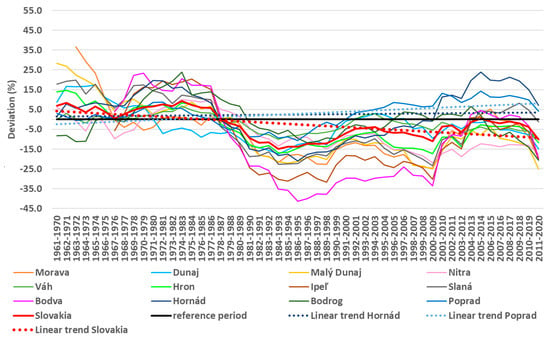
Figure 2.
The course of 10-year moving values of the average deviations (%), reference period 1961–2000.
Note: In Figure 2, Figure 3 and Figure 4 the linear trend lines for the sub-basins are marked only if the linear trend direction is opposite to the direction of the trend for the whole of Slovakia.
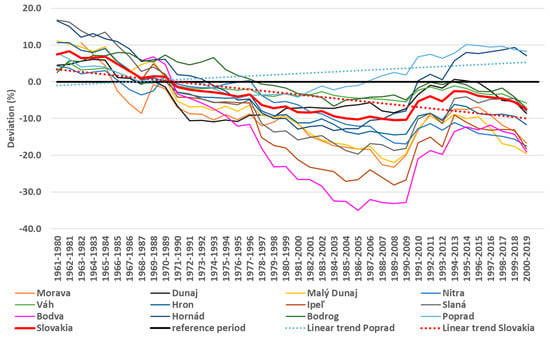
Figure 3.
The course of 20-year moving values of the average deviations (%), reference period 1961–2000.
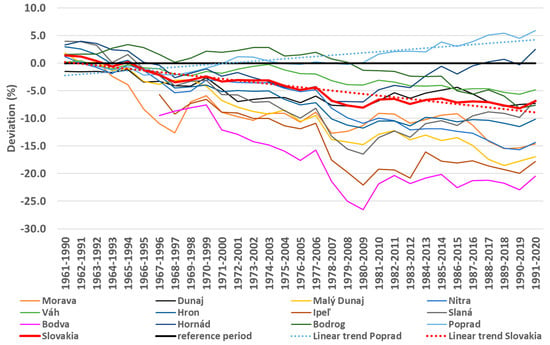
Figure 4.
The course of 30-year moving values of the average deviations (%), reference period 1961–2000.
The largest value of the average deviation of the river sub-basin reached a value of −41.4% (Bodva River sub-basin, 10-year period 1986–1995). In the Bodva and Ipeľ River sub-basins, the deviation almost continuously reached a value between −25% to −40% during the long period of the 10-year moving periods (10-year period 1981–1990 up to the 10-year period 2000–2009) and in several consecutive 10-year moving periods in the Morava, Malý Dunaj and Slaná River sub-basins. A different evolution was recorded in the Váh River sub-basin and Poprad River sub-basin. The average deviation values for these sub-basins in almost all individual decades were less than 10% (absolute value).
The evaluation for the reference period 1961–2020 shows very similar results. The values of the average percentage deviations of the territory of Slovakia and in the individual 10-year moving periods also show decreasing or balanced linear trends. The range of the average deviation values for the individual 10-year moving periods is from −38.3% to 36.0%.
From these results, it can be concluded that the 10-year period is too short for the evaluation of the long-term changes as well as too short for being used as a potential “normal” for further evaluations.
3.3. The 20-Year Moving Periods
The course of the 20-year moving values of the average percentage deviations for the territory of Slovakia and in individual river sub-basins, with the exception of the Poprad River sub-basin, shows a more significant decreasing linear trend (Figure 3). The range of the values of the 20-year moving periods for Slovakia is from −10.4% (20-year period 1989–2008) to 10.7% (20-year period 1962–1981). In the individual basins, the variability is from −35.0% (Bodva River sub-basin, 20-year period 1986–2005) to 16.8% (Slaná River sub-basin and Hornád River sub-basin, both in the 20-year period 1961–1980).
It is interesting that the period after the year 2000 has not been assessed as the driest period. For the evaluation with this conclusion, the 20-year period prevails, which includes the years between 1985 and 1993. The period after the year 2000 begins to show some stability. Based on the results, it can be concluded that the 20-year period is too short for the evaluation of the long-term changes and as well as too short for being “normal” for further evaluations.
3.4. The 30-Year Moving Periods
The course of the 30-year moving values of the average percentage deviations of Slovak territory and in the individual sub-basins, except for the Poprad River sub-basin, shows an even more significant decreasing trend (Figure 4) than for the 20-year moving values. The range of values of the 30-year moving periods for Slovakia ranges from −8.2% (30-year period 1990–2019) to 2.1% (30-year period 1961–1990).
From the 30-year period 1980–2009, we have observed a certain change in the 30-year moving values’ average deviations (Figure 5). It is this period that observes the range of values for the whole evaluated period. The range of values within the individual river basins is not significant (up to 10%). All the values of the average deviation are negative, except for the Poprad River sub-basin and partially the Hornád River sub-basin (Figure 5). The changes can be seen in the Hornád and the Slaná River sub-basins, where we have identified an increasing linear trend.
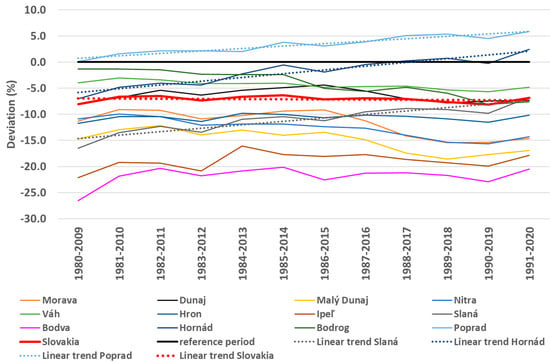
Figure 5.
The course of 30-year moving values of the average deviations (%) for the period 1980–2020, reference period 1961–2000.
The 30-year period 1991–2020 is recommended by WMO [14] as the unified period for a comparison of hydrological and climatic characteristics. Therefore, the next analysis focuses on this period. This unification is proposed primarily for the purpose of the comparison of the hydrological and climatic characteristics.
In Slovakia, during the transition to the reference period 1961–2000, the Map of Vulnerability and Sensitivity of the Average Runoff was processed, based on the results of the comparison of two reference periods for hydrological characteristics, the periods 1931–1980 and 1961–2000 [17,18]. The map has shown the division of the Slovak territory into different areas after evaluating the basic components of the average annual values of the hydrological balance (precipitation, runoff) and estimating in which parts of the territory certain changes in the runoff were identified. For example, it means that the values of the runoff for the period 1961–2000 in areas designated as highly sensitive decreased by up to 20%.
Focusing on the 30-year period 1991–2020 in more detail, we can state that the spatial display of the deviations almost identically coincides with the Map of Vulnerability and Sensitivity of the Average Runoff except for the area bordering the Czech Republic marked as an area prone to changes (Figure 6).
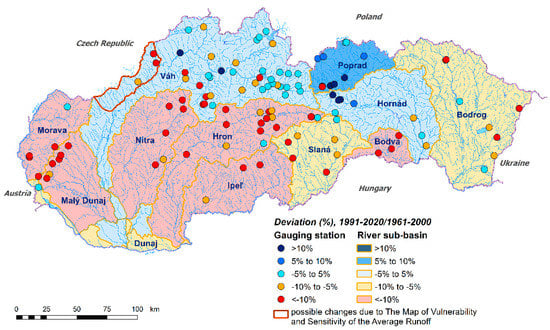
Figure 6.
The flow rates average deviation (%) for the area of Slovakia and its river sub-basins and evaluated water-gauging stations for the period 1991–2020 (reference period 1961–2000).
According to the results of the evaluation of the 30-year period 1991–2020 compared to the reference period 1961–2000, we can already assume that another part of the Váh River sub-basin will be classified as a moderately sensitive and moderately vulnerable area (Figure 6). According to this distribution, it seems that the sub-basins of the Hornád River and the Poprad River stand out because of an increase in the values of the average deviation that has been identified there. In the Poprad River sub-basin and in the upper part of the Hornád River sub-basin, deviation values higher than 10% have been evaluated (Figure 7). In terms of absolute values of the deviations in the individual water-gauging stations, the classification of these sub-basins stays the same. These results are consistent with the previous study [18], where data up to the year 2015, including the changes and the trends, have been evaluated. Compared to the reference period 1961–2020, the situation is similar, with a possible exception of the Bodrog River sub-basin (Figure 7). The evaluation of the reference period 1961–2020 is irrelevant from the point of view of the changes against the original Map of Vulnerability and Sensitivity of the Average Runoff.
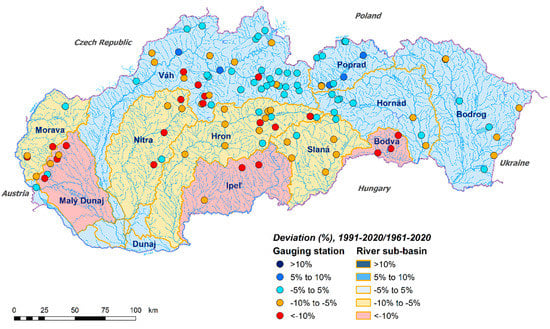
Figure 7.
The flow rates average deviation (%) for the area of Slovakia and the river sub-basins and evaluated water-gauging stations for the period 1991–2020 (reference period 1961–2020).
3.5. The 40-Year and 50-Year Moving Periods
The 40-year and 50-year moving periods have been evaluated in the same way. The 40-year and the 50-year periods with the lowest value of the % difference have always included the period after the year 2000.
The lowest values have been recorded for the 40-year periods compared to the reference period 1961–2000, which means that the currently used reference period 1961–2000 still has some telling value for the assessment of the average hydrological characteristics.
The minimum values of the average deviation of individual n-years moving periods have been significantly higher, but they have also decreased with the extension of the period. The lowest recorded values have been evaluated for the 50-year-long periods, but they have still exceeded 10% in some river sub-basins (Morava, Malý Dunaj, Ipeľ, Bodva River sub-basins).
As expected, the last 40-year period (1981–2020) and the 50-year period (1971–2020), due to the level of long-term low flow, are rated as the least water-bearing of the periods in almost all sub-basins. The difference is in the Poprad River sub-basin for both n-year periods.
4. Conclusions
The evaluation of the hydrological regime through the analysis of the moving averages was conducted with the intention to re-evaluate the currently used reference period used as hydrological design values in national decision-making processes. The course of the moving values of the average deviations for the 10-year and the 20-year periods with respect to the selected time step (1 year) shows relatively significant differences in individual n-year-long moving periods. This indicates that such a period is too short for a long-term regime evaluation [19].
The 30-year period can potentially be used as a reference period for evaluating current changes in the average flow and for evaluating the hydrological balance components as a part of studies of climate change. However, for an establishment of the length of the newly proposed reference period to be used in water management in Slovakia, it is necessary to undertake more detailed analyses, especially analyses of the low flow characteristics. There is also an option to consider the establishment of the appropriate probability values [20].
The lowest values of the deviations were recorded for the 40-year periods compared to the valid reference period 1961–2000, which means that this reference period, still currently used in Slovakia for water management, does not need to be dismissed when assessing the average hydrological characteristics. However, from the outlined findings, it is clear that it is no longer fully sufficient to evaluate the characteristics of the low flows, and the newly proposed reference period must include the years after the year 2000.
The results of the evaluation of the hydrological regime of the streams in Slovakia show a decrease in the average flow in almost all sub-basins. The results indicated that the use of the 30-year long period 1991–2020 is probably suitable, especially for mutual comparison between climatic and hydrological characteristics for climate change research. The main issue remains the establishment of a new reference period for design values used in water management. This is a sensitive topic, because these characteristics, especially in the area of low flows, have a direct impact on water use (e.g., dam management, permissions for water use, sewage systems). Therefore, the main question to be addressed in further research remains the evaluation of the characteristics of low flows in particular and the establishment of the reference period regarding possible new reference values, especially considering their purpose and possible consequences for the already implemented measures. It is possible that the establishment of the reference low-flow hydrological characteristics will be approached differently, especially with regard to the protection of water resources on the one hand and the optimal provision of water requirements on the other.
Author Contributions
Conceptualization, J.P.; methodology, J.P. and L.B.; validation, Z.D., K.J. and K.K.; formal analysis, L.B., K.J., K.M. and K.K.; data curation, Z.D., L.B., K.J., K.M. and K.K.; writing—original draft preparation, J.P. and K.J.; writing—review and editing, L.B., K.J., K.M. and K.K.; visualization, Z.P. and K.J.; supervision, J.P. All authors have read and agreed to the published version of the manuscript.
Funding
This research received no external funding.
Data Availability Statement
Restrictions apply to the availability of these data. Data were obtained from the SHMI and can be requested directly from the SHMI according to their data provision policies.
Acknowledgments
This work was supported by the Slovak Research and Development Agency under Contract no. APVV-20-0374.
Conflicts of Interest
The authors declare no conflict of interest.
References
- WMO. Provisional State of the Global Climate in 2022. Available online: https://library.wmo.int/doc_num.php?explnum_id=11359 (accessed on 24 February 2023).
- Fendeková, M.; Danáčová, Z.; Gauster, T.; Labudová, L.; Fendek, M.; Horvát, O. Analysis of hydrological drought parameters in selected catchments of the souther and eastern Slovakia in the years 2003, 2012 and 2015. Acta Hydrol. Slovaca 2017, 18, 135–144. [Google Scholar]
- Danáčová, Z.; Jeneiová, K.; Blaškovičová, L. Hydrological situation on Slovak rivers from the point of view of hydrological drought assessment in the period 2011–2020. Acta Hydrol. Slovaca 2021, 22, 230–236. [Google Scholar] [CrossRef]
- Halmová, D.; Pekárová, P.; Pekár, J.; Miklánek, P.; Bačová Mitková, V. Identification of the historical drought occurrence on the Danube River and its tributaries. Acta Hydrol. Slovaca 2021, 22, 237–247. [Google Scholar] [CrossRef]
- Pekárová, P.; Mészáros, J.; Miklánek, P.; Pekár, J.; Siman, C.; Podolinská, J. Post-flood field investigation of the June 2020 flash flood in the upper Muráň River basin and the catastrophic flash flood scenario. J. Hydrol. Hydromech. 2021, 69, 288–299. [Google Scholar] [CrossRef]
- Pekárová, P.; Miklánek, P.; Pekár, J.; Pramuk, B. Identifikácia zmien režimu denných prietokov slovenských riek II. časť: Porovnanie dvoch období [Identification of the Slovak rivers daily discharge regime changes. Part II.: Comparison of the two periods]. Acta Hydrol. Slovaca 2017, 18, 183–192. [Google Scholar]
- Fendeková, M.; Gauster, T.; Labudová, L.; Vrablíková, D.; Danáčová, Z.; Fendek, M.; Pekárová, P. Analysing 21st century meteorological and hydrological drought events in Slovakia. J. Hydrol. Hydromech. 2018, 66, 393–403. [Google Scholar] [CrossRef]
- Poórova, J. (Ed.) Evaluation of Hydrological Drought, The Annual Runoff and the Changes of Runoff Distribution during the Year; Partial Report; SHMÚ: Bratislava, Slovakia, 2019; 110p, ISBN 978-80-99929-09-9. [Google Scholar]
- Holko, L.; Sleziak, P.; Danko, M.; Bičárová, S.; Pociask-Karteczka, J. Analysis of changes in hydrological cycle of a pristine mountain catchment. 1. Water balance components and snow cover. J. Hydrol. Hydromech. 2020, 68, 180–191. [Google Scholar] [CrossRef]
- Ďurigová, M.; Hlavčová, K. The detection of changes in the upper Váh river basin according to a decadal analysis. Acta Hydrol. Slovaca 2020, 21, 39–47. [Google Scholar] [CrossRef]
- Halmová, D.; Pekárová, P.; Podolinská, J.; Jeneiová, K. The assessment of changes in the long-term water balance in the Krupinica River basin for the period 1931–2020. Acta Hydrol. Slovaca 2022, 23, 21–31. [Google Scholar] [CrossRef]
- Kubiak-Wójcicka, K.; Nagy, P.; Pilarska, A.; Zeleňáková, M. Trend Analysis of Selected Hydroclimatic Variables for the Hornad Catchment (Slovakia). Water 2023, 15, 471. [Google Scholar] [CrossRef]
- Jeneiová, K.; Blaškovičová, L.; Labat, M.M.; Melová, K.; Síčová, B.; Poórová, J. Assesment of the changes in the mean annual discharge in the Bodrog River basin during 1961–2020. In Water Regime of Natural Areas 2022; Pavelková, D., Gomboš, M., Tall, A., Eds.; IH SAS, E-Book: Bratislava, Slovakia, 2022; 215p, ISBN 978-80-89139-52-1. [Google Scholar]
- WMO. Statement on the Term Hydrological Normal, Hydrological Coordination Panel. Available online: https://community.wmo.int/activity-areas/hydrology-and-water-resources/hydrological-coordination-panel (accessed on 27 January 2023).
- Poórova, J. (Ed.) Hydrologické charakteristiky, časť 1: Analýza vplyvu dĺžky referenčného obdobia na dlhodobý prietok. In Slovak. Hydrological Characteristic. Analysis of the Influence of the Length of the Reference Period on the Long-Term Discharge; Partial Report; SHMÚ: Bratislava, Slovakia, 2023; (manuscript in preparation). [Google Scholar]
- Kobolt, M.; Ulaga, F. Influence of 30-year reference period on characteristic periodic discharges. In Proceedings of the XXIX Conference of the Danube Countries on Hydrological Forecasting and Hydrological Bases of Water Management, Brno, Czech Republic, 6–8 September 2021; pp. 38–49, ISBN 978-80-7653-031-7. [Google Scholar]
- Poórová, J.; Blaškovičová, L.; Škoda, P.; Šimor, V. Trendy minimálnych ročných a mesačných prietokov na slovenských tokoch. In Proceedings of the Seminar: Sucho a Jak Mu Čelit; ČSVTS: Praha, Czech Republic; May 2013.
- Blaškovičová, L. (Ed.) Hodnotenie hydrologického sucha, časť 2: Hodnotenie zmien a trendov mesačných a ročných prietokov. In Hydrological Drought Evaluation, Part 2: Evaluation of Changes and Trends in Monthly and Yearly Discharges; Partial Report; SHMÚ: Bratislava, Slovakia, 2019; 64p, ISBN 978-80-99929-14-3. [Google Scholar]
- Poórová, J.; Jeneiová, K.; Labat, M.M.; Danáčová, Z. Impact of the Reference Period Length on Hydrological Characteristics. In Proceedings of the 2nd Conference of Mediterranean Geosciences Union (MedGU), Abstract Book, Annual Meeting, Marrakech, Morocco, 27–30 November 2022. [Google Scholar]
- Niranjani, P.K.; Semananda, G.H. Estimation of low flow statistics for Sustainable Water Resources Management in South Australia. Hydrology 2022, 9, 152. [Google Scholar] [CrossRef]
Disclaimer/Publisher’s Note: The statements, opinions and data contained in all publications are solely those of the individual author(s) and contributor(s) and not of MDPI and/or the editor(s). MDPI and/or the editor(s) disclaim responsibility for any injury to people or property resulting from any ideas, methods, instructions or products referred to in the content. |
© 2023 by the authors. Licensee MDPI, Basel, Switzerland. This article is an open access article distributed under the terms and conditions of the Creative Commons Attribution (CC BY) license (https://creativecommons.org/licenses/by/4.0/).